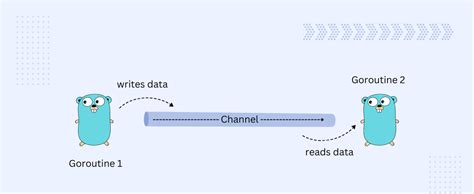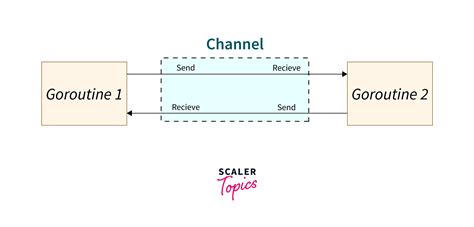how does chanel golang worlk | golang channel codes how does chanel golang worlk Why exactly do we use channels? Channels give us a safe way for goroutines to communicate and also to keep their actions in sync. While the usual method of using locks to . $19K+
0 · golang send channels
1 · golang data channels
2 · golang create channels
3 · golang closing channel
4 · golang channel generator
5 · golang channel codes
6 · golang chan
7 · channel loop in golang
A visual masterpiece, the latest version of the Perpetual 1908 is now available in 950 platinum with an ice blue, rice-grain motif dial. More on rolex.com.
hchan is the central data structure for a channel, with send and receive linked lists (holding a pointer to their goroutine and the data element) and a closed flag. There's a Lock embedded structure that is defined in runtime2.go and that serves as a mutex (futex) or . In this post, we’ll cover the general uses of Go channels, including how to write into and read from a channel, how to use channels as function parameters, and how to use .
Channels are a medium that the goroutines use in order to communicate effectively. It is the most important concept to grasp after understanding how goroutines work. . Why exactly do we use channels? Channels give us a safe way for goroutines to communicate and also to keep their actions in sync. While the usual method of using locks to .
Channels are a typed conduit through which you can send and receive values with the channel operator, <-. ch <- v // Send v to channel ch. v := <-ch // Receive from ch, and. // assign value . Channels in Go provide a way for goroutines (concurrently executing functions) to communicate and synchronize their actions. Think of channels as pipes that connect . Channels: The Basics. Channels serve as a means of communication and synchronization between different goroutines. In fact, there are three main types of channels . This post highlights how channels work in Go, and how you can use them in your code. In Go, a channel is a programming construct that allows us to move data between .
What are Go Channels? Channels are the conduits that allow goroutines (lightweight threads) to communicate with one another and synchronize their execution. They .
hchan is the central data structure for a channel, with send and receive linked lists (holding a pointer to their goroutine and the data element) and a closed flag. There's a Lock embedded structure that is defined in runtime2.go and that serves as a mutex (futex) or semaphore depending on the OS.
Channels provide mechanisms for concurrent execution of functions to communicate by sending and receiving values of a specific element type. Creating a Go channel. It is easy to create Go channels. You only need to define a channel, channel type using the make function and assign that to a variable. In this post, we’ll cover the general uses of Go channels, including how to write into and read from a channel, how to use channels as function parameters, and how to use range to iterate over them. Channels are a medium that the goroutines use in order to communicate effectively. It is the most important concept to grasp after understanding how goroutines work. This post aims to provide a detailed explanation of the . Why exactly do we use channels? Channels give us a safe way for goroutines to communicate and also to keep their actions in sync. While the usual method of using locks to control access to data can be tricky and might cause deadlocks, channels make managing concurrency straightforward.
Channels are a typed conduit through which you can send and receive values with the channel operator, <-. ch <- v // Send v to channel ch. v := <-ch // Receive from ch, and. // assign value to v. (The data flows in the direction of the arrow.) Channels in Go provide a way for goroutines (concurrently executing functions) to communicate and synchronize their actions. Think of channels as pipes that connect goroutines, enabling them to send and receive values, creating a means for coordination and data sharing. Creating a Channel. Channels: The Basics. Channels serve as a means of communication and synchronization between different goroutines. In fact, there are three main types of channels we can explore: Buffered. This post highlights how channels work in Go, and how you can use them in your code. In Go, a channel is a programming construct that allows us to move data between different parts of our code, often from different goroutines.
What are Go Channels? Channels are the conduits that allow goroutines (lightweight threads) to communicate with one another and synchronize their execution. They are type-safe, ensuring that data. hchan is the central data structure for a channel, with send and receive linked lists (holding a pointer to their goroutine and the data element) and a closed flag. There's a Lock embedded structure that is defined in runtime2.go and that serves as a mutex (futex) or semaphore depending on the OS. Channels provide mechanisms for concurrent execution of functions to communicate by sending and receiving values of a specific element type. Creating a Go channel. It is easy to create Go channels. You only need to define a channel, channel type using the make function and assign that to a variable.

In this post, we’ll cover the general uses of Go channels, including how to write into and read from a channel, how to use channels as function parameters, and how to use range to iterate over them. Channels are a medium that the goroutines use in order to communicate effectively. It is the most important concept to grasp after understanding how goroutines work. This post aims to provide a detailed explanation of the . Why exactly do we use channels? Channels give us a safe way for goroutines to communicate and also to keep their actions in sync. While the usual method of using locks to control access to data can be tricky and might cause deadlocks, channels make managing concurrency straightforward.
Channels are a typed conduit through which you can send and receive values with the channel operator, <-. ch <- v // Send v to channel ch. v := <-ch // Receive from ch, and. // assign value to v. (The data flows in the direction of the arrow.) Channels in Go provide a way for goroutines (concurrently executing functions) to communicate and synchronize their actions. Think of channels as pipes that connect goroutines, enabling them to send and receive values, creating a means for coordination and data sharing. Creating a Channel.
golang send channels
golang data channels
Channels: The Basics. Channels serve as a means of communication and synchronization between different goroutines. In fact, there are three main types of channels we can explore: Buffered.
This post highlights how channels work in Go, and how you can use them in your code. In Go, a channel is a programming construct that allows us to move data between different parts of our code, often from different goroutines.

golang create channels
golang closing channel
golang channel generator

Search the largest and most accurate independent site for today in history. Historical events from year 1847. Learn about 69 famous, scandalous and important events that happened in 1847 or search by date or keyword.
how does chanel golang worlk|golang channel codes



























